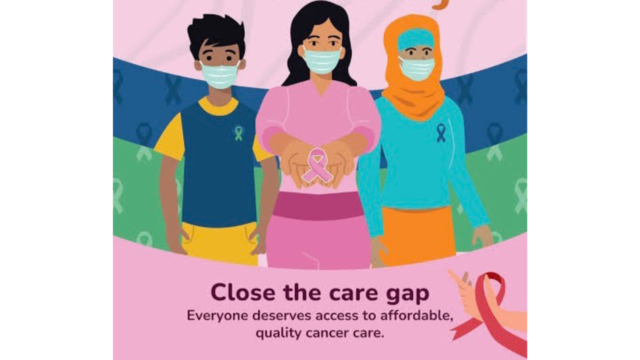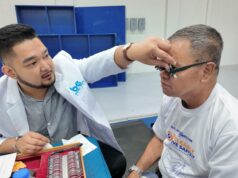Cancer, in all its forms, has been the second leading cause of death in Central Luzon from 2019 to 2022 based on the Field Health Service Information System data of the Department of Health (DOH).
With this, DOH calls on the public’s attention on the threats that cancer poses not only among individuals and their families but also to communities.
Understanding the Science behind the Dreaded C
DOH Central Luzon Center for Health Development (CLCHD) Non-communicable Diseases Cluster Senior Health Program Officer Agnes Alipio explained that cancer is a medical condition caused when the body’s cells grow and divide out of control, which may potentially spread to other organs of the body.

“When these cells overproduce, they can form a mass called a tumor. The tumor can be benign (non-cancerous) or malignant (cancerous). When the tumor is malignant, it can grow and spread to other parts of the body. Meanwhile, there are other types of cancer that do not develop tumors, such as leukemia,” she said.
In the Philippines, the leading cause of cancer-related mortality is breast cancer followed by lung, colon, and liver.
Worldwide, cancer is a leading cause of death that accounts for nearly 10 million deaths in 2020 or nearly one in six deaths, according to the World Health Organization.
“Age, unhealthy lifestyle, genetics, and other environmental toxins may increase the risk of developing cancers,” Alipio said.

DOH also warned the public to look out for the signs and symptoms of cancer which include changes in bladder/bowel habits, sores that do not heal, unusual bleeding or discharge, thickening or lump in breast or elsewhere, indigestion or difficulty in swallowing, obvious changes in warts or moles, nagging cough or persistent hoarseness, unexplained weight loss, and pernicious anemia.
The Burden of Cancer
Aside from the alarming figures that make cancer a serious global health threat, what makes it worse is that cancer is tied to many other diseases.
“When we talk of cancer, we have the primary cancer which is the main site of the tumor and the metastatic cancers or those that spread to other organs or part of the body,” Alipio said.
Aside from the physical burden that the disease causes on the patient because of various medications and treatments, it also causes emotional stress on the patients and their loved ones.
Pain is always associated with cancer because approximately one-fourth of newly diagnosed cancer patients experience some degree of pain, as do one-third of patients undergoing cancer treatment, and three-quarters of patients with advanced disease.
DOH said that cancer also has significant economic costs and impacts heavily on the families’ resources. Many of those who are diagnosed with the disease lose the opportunity to work as the disease progresses. It also sometimes prevents other family members from continuing working, as patients have to be taken care of, thus resulting in loss of income and even any savings they may have due to the overwhelming cost of medical treatment.
Closing the gap
Despite these, DOH reassures that cancer is preventable. Health authorities suggest that individuals maintain a healthy diet rich in fruits and vegetables, limit consumption of red and processed meats, avoid tobacco smoking and vaping, limit alcohol intake, and engage in regular physical activity to reduce the risks associated with developing cancer.
In fact, Alipio said that this year’s World Cancer Day theme “Close the Care Gap”, highlights the disparities in access to cancer care that exist around the world.
“The goal is to ensure that everyone, regardless of where they live or their socioeconomic status, has access to quality cancer prevention, screening, treatment, and palliative care,” she stressed.
One of DOH CLCHD’s efforts is the conduct of capacity development activities like seminars and workshops for local government unit (LGU) health workers to provide them with the proper knowledge regarding the disease, its risks, and symptoms.
“Because we are teaching our health workers, our goal is to be able to screen early. They should be able to determine what to look out for and what to do so that patients can be diagnosed early,” she said.
Alipio also shared that they also establish the referral pathway so that health workers know where and how to refer patients suspected of having cancer in order to guide them where to receive the right services from the government.
“We also encourage our LGUs to establish clubs like the hypertension and cancer club so that these people can help each other to encourage other people to adopt a healthy lifestyle,” Alipio added.
DOH also has the Cancer Supportive Care and Palliative Care Medicine Access Program (CSPMAP) which aims to provide free medicines to identified priority sets of cancer types that are not yet fully covered by the Philippine Health Insurance Corporation to avoid or minimize out of pocket costs among the target population.
In Central Luzon, the three CSPMAP access sites are Jose B. Lingad Memorial General Hospital in the City of San Fernando, Bataan General Hospital and Medical Center in Balanga City, and Dr. Paulino J. Garcia Memorial Research and Medical Center in Cabanatuan City.
Assistance can likewise be provided by DOH CLCHD to qualified cancer patients through the Malasakit program and Medical Assistance for Indigent Patients. (CLJD/MJSC-PIA 3)





